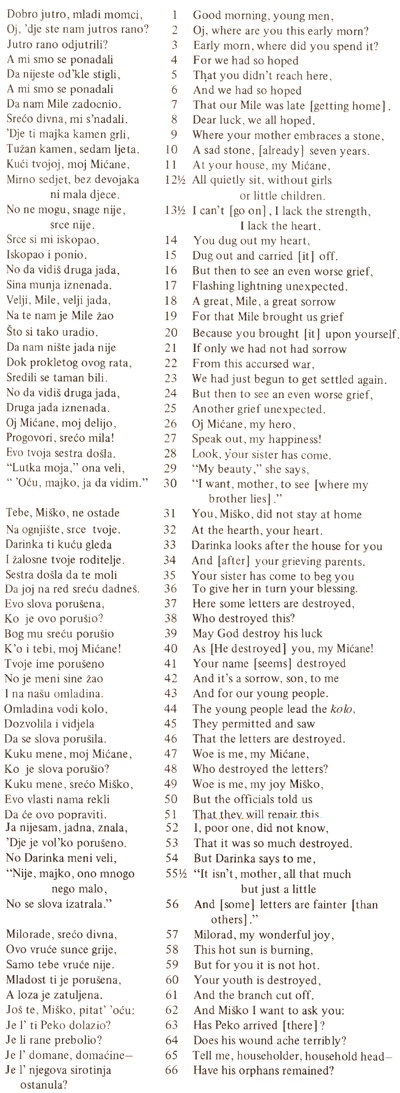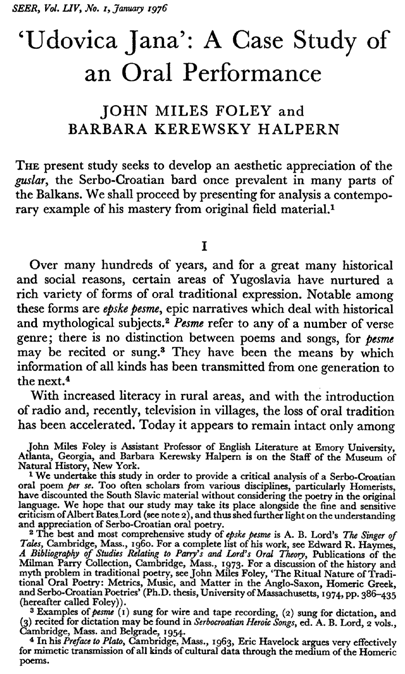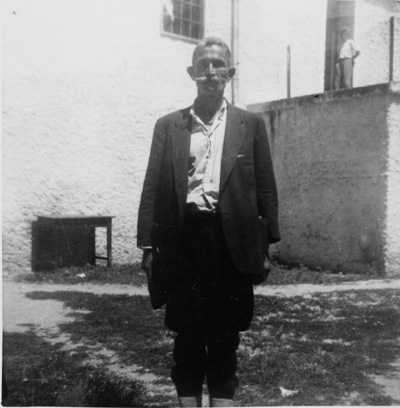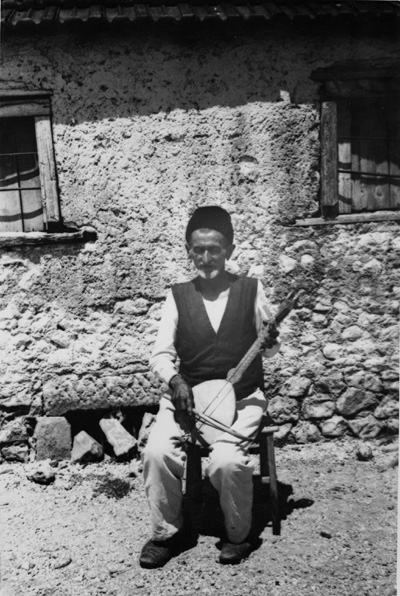Eighth Word: An Ecology of South Slavic Oral Poetry
Bajanje: A healing charm to cure erysipelas
Lament for Milorad
The Widow Jana
Epic Singers
Bajanje: A healing charm to cure erysipelas
These two performances of bajanje were given to us by Desanka Matijasevic (DM), longtime resident and prominent bajalica (conjurer) in the Serbian village of Orasac. She is summoning a series of agents or helpers, all coded with the color red, to assist her in curing a patient afflicted with erysipelas, a streptococcus skin infection. As the clip begins, she and Barbara Kerewsky-Halpern (BKH), my co-fieldworker, are discussing the dynamics of such magical spells; sitting alongside them is DM's daughter Nada, who occasionally joins the conversation. The conjurer's most immediate pomocnik ("helper"), her six-year-old grandson, occupies the older woman's lap.
Eager to be part of things, the little boy prompts his grandmother with a partial verse from the charm he has apparently heard many times before: "Kako do-dodje, tak-..." ("As he comes, so [he approaches]"; see version B1, line 5). Anticipating that DM is about to begin and noticing her nervousness in performing for the tape recorder, his mother Nada appreciatively and gently deflects his enthusiasm. "Oh no, granny's starting now, so just listen," she chides, and the first performance is underway. You can follow along by consulting the original-language transcription and English translation (version B1).

The first performance ends with two verses that always close this kind of charm, no matter what variations occur within the given version:
U kurjaka cetiri noge, peti rep,
Od mog odgovora j' bio lek.
Into the wolf's four legs, fifth the tail,
Out of my speaking has come the cure.
The second performance of the bajanje against erysipelas was prompted by BKH's question about an alternate form for the magical spell. On our first visit we had heard DM employ mysterious adjectives like aloviti ("wavy" or "powerful") and viloviti ("lively" or "magical") to describe the agents she was summoning from the other world to assist her in rooting out the disease. DM quickly recognizes what is wanted and immediately launches into a version that illustrates the fundamental role (and rule) of multiformity in oral poetry - variation within limits. Listen closely and you will hear many lines and groups of lines from the first performance, but with substitutions and inversions. Rules and patterns unquestionably govern the bajalica's charm-making, but they never fossilize her words, which remain a performed utterance, a living "word." For further discussion, see HROP, pages 190-95.
Lament for Milorad

The kind of oral poetry that villagers call tuzbalica is a very important - because highly functional - type of verbal art in the community. When a person dies, the closest female relative composes a mourning poem, based on two sources: the specialized octosyllabic idiom assigned uniquely to this kind of poetry and individualized facts and events from the life of the deceased person. In the case of the example cited here, the task was particularly difficult. Instead of passing away after a full life, the young boy Milorad was the victim of a freak accident: he was struck by lightning while crossing a field on the way home from a regional fair. Nonetheless, his mother manages to turn this tradtional "way of speaking" to an unprecedented purpose, formulating a poem that embodies her and the community's pointed and specific sadness while framing her grief within a familiar frame of reference. Custom calls for the performance to be repeated, always at the gravesite, at gradually increasing intervals for up to five years. For further discussion, see HROP, pages 195-99.
The Widow Jana
Aleksandar Jakovljevic sang this performance of Udovica Jana or The Widow Jana for anthropologists Joel Halpern and Barbara Kerewsky Halpern in the village of Orasac, 80 km. south of Belgrade, in 1951. It belongs to the Christian tradition of epic, and to the category of "unfaithful mother" stories, which seem to provide a negative or inverse example of proper behavior for the community. You can listen to Jakovlejvic's performance by clicking on the appropriate link below, as well as follow along with the original-language text and English translation by clicking on the thumbnailed pages. I have provided a copy of the complete article, "Udovica Jana: A Case Study of an Oral Performance," J.M. Foley and B.K. Halpern, Slavonic and East European Review, 54 (1976): 11-23. For further discussion, see HROP, pages 207-8.

Epic Singers
Halil Bajgoric, a guslar from Dabrica in the Former Yugoslavia. Photo by A. B. Lord. Courtesy of the Curators of the Milman Parry Collection of Oral Literature. Copyright President and Fellows of Harvard University. (See HROP, pp. 211-13.)

Ibro Basic, a guslar from Stolac in the Former Yugoslavia. Photo by A. B. Lord. Courtesy of the Curators of the Milman Parry Collection of Oral Literature. Copyright President and Fellows of Harvard University. (See HROP, pp. 210.)

Useful Links
| www.rastko.org.yu/isk/nmilosevic-oral_tradition.html | "The Oral Serbian Tradition," by Nada Milosevic-Djordjevic |
| home.earthlink.net/~markdlew/SerbEpic/ | Serbian Epic Poetry, examples and background |


